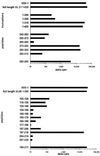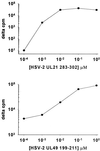Tegument-specific, virus-reactive CD4 T cells localize to the cornea in herpes simplex virus interstitial keratitis in humans
- PMID: 11069987
- PMCID: PMC113172
- DOI: 10.1128/jvi.74.23.10930-10938.2000
Tegument-specific, virus-reactive CD4 T cells localize to the cornea in herpes simplex virus interstitial keratitis in humans
Abstract
Herpes stromal keratitis (HSK) is a prevalent and frequently vision-threatening disease associated with herpes simplex virus type 1 (HSV-1) infection. In mice, HSK progression occurs after viral clearance and requires T cells and neutrophils. One model implicates Th1-like CD4 T cells with cross-reactivity between the HSV-1 protein UL6 and a corneal autoantigen. HSK can be prevented by establishing specific immunological tolerance. However, HSK can also occur in T-cell receptor-transgenic X SCID mice lacking HSV-specific T cells. To study the pathogenesis of HSK in the natural host species, we measured local HSV-specific T-cell responses in HSK corneas removed at transplant surgery (n = 5) or control corneas (n = 2). HSV-1 DNA was detected by PCR in two specimens. HSV-specific CD4 T cells were enriched in three of the five HSK specimens and were not detectable in the control specimens. Reactivity with peptide epitopes within the tegument proteins UL21 and UL49 was documented. Responses to HSV-1 UL6 were not detected. Diverse HLA DR and DP alleles restricted these local responses. Most clones secreted gamma interferon, but not interleukin-5, in response to antigen. HSV-specific CD8 cells were also recovered. Some clones had cytotoxic-T-lymphocyte activity. The diverse specificities and HLA-restricting alleles of local virus-specific T cells in HSK are consistent with their contribution to HSK by a proinflammatory effect.
Figures



Similar articles
-
Herpes simplex virus-specific T cells infiltrate the cornea of patients with herpetic stromal keratitis: no evidence for autoreactive T cells.Invest Ophthalmol Vis Sci. 2000 Aug;41(9):2607-12. Invest Ophthalmol Vis Sci. 2000. PMID: 10937573
-
Identification and characterization of herpes simplex virus-specific CD4+ T cells in corneas of herpetic stromal keratitis patients.J Infect Dis. 1998 Feb;177(2):484-8. doi: 10.1086/517382. J Infect Dis. 1998. PMID: 9466544
-
Restricted T cell receptor beta-chain variable region protein use by cornea-derived CD4+ and CD8+ herpes simplex virus-specific T cells in patients with herpetic stromal keratitis.J Infect Dis. 2003 Feb 15;187(4):550-8. doi: 10.1086/367991. Epub 2003 Jan 29. J Infect Dis. 2003. PMID: 12599071
-
How herpes simplex virus type 1 rescinds corneal privilege.Chem Immunol Allergy. 2007;92:203-212. doi: 10.1159/000099271. Chem Immunol Allergy. 2007. PMID: 17264496 Review.
-
Role of Herpes Simplex Virus Type 1 (HSV-1) Glycoprotein K (gK) Pathogenic CD8+ T Cells in Exacerbation of Eye Disease.Front Immunol. 2018 Dec 7;9:2895. doi: 10.3389/fimmu.2018.02895. eCollection 2018. Front Immunol. 2018. PMID: 30581441 Free PMC article. Review.
Cited by
-
Mucosal herpes immunity and immunopathology to ocular and genital herpes simplex virus infections.Clin Dev Immunol. 2012;2012:149135. doi: 10.1155/2012/149135. Epub 2012 Dec 24. Clin Dev Immunol. 2012. PMID: 23320014 Free PMC article. Review.
-
Human CD4+ CD25 high cells suppress proliferative memory lymphocyte responses to herpes simplex virus type 2.J Virol. 2006 Aug;80(16):8271-3. doi: 10.1128/JVI.00656-06. J Virol. 2006. PMID: 16873284 Free PMC article.
-
A Human Stem Cell-Derived Neurosensory-Epithelial Circuitry on a Chip to Model Herpes Simplex Virus Reactivation.Biomedicines. 2022 Aug 24;10(9):2068. doi: 10.3390/biomedicines10092068. Biomedicines. 2022. PMID: 36140168 Free PMC article.
-
Cell surface major histocompatibility complex class II proteins are regulated by the products of the gamma(1)34.5 and U(L)41 genes of herpes simplex virus 1.J Virol. 2002 Jul;76(14):6974-86. doi: 10.1128/jvi.76.14.6974-6986.2002. J Virol. 2002. PMID: 12072498 Free PMC article.
-
HSV-2-Specific Human Female Reproductive Tract Tissue Resident Memory T Cells Recognize Diverse HSV Antigens.Front Immunol. 2022 Mar 31;13:867962. doi: 10.3389/fimmu.2022.867962. eCollection 2022. Front Immunol. 2022. PMID: 35432373 Free PMC article.
References
-
- Asanuma H, Sharp M, Maecker H T, Maino V C, Arvin A M. Frequencies of memory T cells specific for varicella-zoster virus, herpes simplex virus and cytomegalovirus determined by intracellular detection of cytokine expression. J Infect Dis. 2000;181:859–866. - PubMed
-
- Avery A C, Zhao Z-S, Rodriguez A, Bikoff E K, Soheilian M, Foster C S, Cantor H. Resistance to herpes stromal keratitis conferred by an IgG2a-derived peptide. Nature. 1995;376:431–434. - PubMed
-
- Brodie S J, Lewinsohn D A, Patterson B K, Jiyamapa D, Krieger J, Corey L, Greenberg P D, Riddell S R. In vivo migration and function of transferred HIV-1-specific cytotoxic T cells. Nat Med. 1999;5:34–41. - PubMed
-
- Brodsky F M, Parham P. New aspects of HLA serology and biochemistry defined using monoclonal antibodies. In: Ferrone S, Solheim B G, editors. HLA typing: methodology and clinical aspects. Vol. 1. Boca Raton, Fla: CRC Press, Inc.; 1982. pp. 23–38.
Publication types
MeSH terms
Substances
Grants and funding
LinkOut - more resources
Full Text Sources
Other Literature Sources
Molecular Biology Databases
Research Materials

